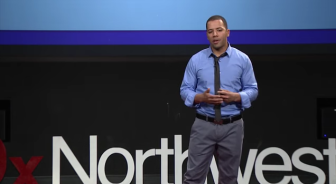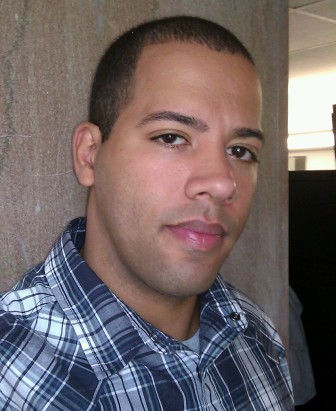
Xavier McElrath-Bey delivering "No Child Is Born Bad" at TEDxNorthwesternU 2014.
The hardliner prosecutor teaching a law course in a women’s maximum-security prison in Tennessee got to know inmates as real people rather than just paperwork. It changed his life so much he quit his job as a prosecutor, saying he could no longer be complicit in a system that warehoused for decades people who committed crimes as teenagers.
The woman who managed an art gallery in a small Pennsylvania town always considered herself a big believer in law and order — and couldn’t imagine befriending a man serving life without parole on a first-degree murder conviction. Then somebody brought some of the inmate’s artwork to her gallery, and she contacted him. Today, she calls him a son, and he calls her “Mom.”
The former Chicago gang member convicted of first-degree murder for his involvement in a fatal stabbing and beating that took place when he was 13 now has a master’s degree, has counseled countless troubled kids and is a youth justice advocate fighting extreme sentencing of juveniles.
The three stories are among those of six people highlighted in a handful of videos produced by the Washington, D.C.-based Campaign for the Fair Sentencing of Youth to illustrate lives touched by lengthy imprisonment of people convicted as juveniles.
The non-profit CFSY put together the videos to mark its five years advocating for more humane treatment of youthful offenders, including by abolishing life-without-parole for juveniles.
“We know there’s a long way to go, but I do think it’s important to convey that these are folks who are having a real impact and people who previously had no hope,” Jody Kent Lavy, CFSY’s director and national coordinator, told JJIE. “Many of them have hope now.
“It is critically important that we amplify these stories as a way to humanize these issues and to demonstrate that all different kinds of people are touched by these practices [extreme sentencing of youth] and it’s important to hear the way that people have been touched.”
An Ex-Prosecutor’s Epiphany
Ever since Preston Shipp interned in a county prosecutor’s office as an undergraduate at Nashville’s Lipscomb University, he dreamed of becoming a prosecutor. And after graduating from the University of Tennessee College of Law, he clerked for a criminal court judge for two years, then became an appellate prosecutor in the Tennessee Attorney General’s Office in 2004.
In that job, he reviewed transcripts, briefs and exhibits of people appealing their convictions and made arguments for why their convictions should stand.
Thus, they became faceless appellants — until he met people doing time for violent crimes when he began teaching a Judicial Process course at a maximum-security women’s prison in Nashville in 2007.
Their life stories would change his mindset forever.
“It’s not like they all of a sudden just up and decided to kill somebody. I never heard that,” Shipp told JJIE. “To a person, they were caught up in some horrible downward spiral that culminated in this tragedy, and they were so remorseful.”
Again and again, Shipp’s students talked of child abuse, being victims of crime, abusing drugs and alcohol, running away from home, ending up on the streets, turning to prostitution.
“In the AG’s office, they [inmates] were just kind of people on the paper, and all I knew about them was what happened at their trials,” Shipp said. “I didn’t have the larger context. I started hearing about how these people were raised, what had happened to them, and it made me feel much more compassionate because I got to hear their stories.”
They also overflowed with compassion and desperately wanted to do good, he said.
“These women are just remarkable — even putting academics aside,” Shipp said. “They’re just good folks. They are just very caring and sensitive and compassionate. And I saw, too, in my conversations with them how much potential they had for good, how many of them had overcome their pasts, people who were capable of providing a whole lot of good, making a positive impact.”
Academically, the prisoners also outperformed students from Shipp’s alma mater, Lipscomb — a small, Christian liberal arts school — who attended the class inside the prison along with the inmates.
“I think it’s because they [the inmates] recognized the opportunity that they had,” he said.
Teaching the class prompted Shipp to quit his appellate prosecutor job in 2008. (He then became a staff attorney at the Tennessee Board of Professional Responsibility, which investigates unethical conduct among lawyers.)
“I started having trouble writing the [appellate] briefs because I thought, ‘Gosh, I don’t know what this person’s been through,’ and if I were in their shoes, I might not have acted any differently,” he said.
Shipp again taught the course in the prison in 2009, and encountered one of his sharpest students yet, Cyntoia Brown.
In 2004, Brown, then a 16-year-old turning tricks for a pimp nicknamed “Cut-throat,” fatally shot a man in Nashville who had picked her up at a Sonic restaurant. Shipp says she was strung out on drugs at the time and had been traumatized after being repeatedly raped in the preceding weeks.
Brown received a 51-year sentence with no chance of parole. But Shipp saw her as something other than a convicted murderer.
“She’s extremely intelligent, and she was very outspoken and opinionated, well-read, just a voracious reader, very hungry for that intellectual challenge,” Shipp recalled. “She really enjoyed coming to class, having read the material and ready to tell you what she thought about it. She had a good sense of humor, very spirited. We became friends pretty quickly.”
He had no hint at the beginning of the spring 2009 semester what a pivotal role he had played in keeping Brown behind bars.
Before he left his prosecutor job, he had handled her appeal, which was denied by the Tennessee Court of Criminal Appeals in April 2009.
“I recognized that she was going to be just heartbroken because she loved that class, and she was so good at it,” Shipp said.
Brown told her teacher and mentor she forgave him and understood he was just doing his job.
For his part, Shipp expressed remorse — and not only over Brown’s case.
“I regret it because I know her, but it also has raised kind of the specter of all the other 300 cases I worked on. What if I had the opportunity to sit down with those people and hear from them? Would I have regrets there too?” said Shipp, 37.
“It’s raised a lot of questions of why did I ever feel comfortable writing a brief or making an argument to a court about somebody who is a stranger when I don’t even know that person. Cyntoia is remarkable, but she’s not unique. There’s a lot of other people who had a horrible, horrible context and they made a bad choice for which they should be held accountable, but not something for which they should just be thrown away forever.”
A Portrait of the Artist As a Juvenile Lifer
Five years ago, someone brought wildlife and nature paintings — done on tree leaves — into the Berwick, Pa., art store Cindy Sanford managed.
She was wowed by the artwork, and so were her customers.
Intrigued, Sanford wanted more of the paintings to sell in her store in the town on the Susquehanna River in east-central Pennsylvania.
Then she discovered the improbable identity of the artist: Kenneth Crawford III, an inmate serving a sentence of life without parole for first-degree murder for his role in a July 1999 double homicide. The slayings of a man and a woman occurred in a trailer in the Paradise Camp Resort in Hollenback Township, near Sanford’s hometown.
Crawford, a 15-year-old from Oklahoma at the time of the killings, had been traveling the country with an 18-year-old accomplice, David Lee Hanley.
The two teens were caught separately after a nine-month, multistate manhunt. Crawford said he had been sleeping when Hanley shot and killed both victims, the Associated Press reported two days after his sentencing in Wilkes-Barre, Pa.
After learning he was an inmate at the “Supermax” State Correctional Institution in Greene County in southwestern Pennsylvania, Sanford wrote to Crawford, requesting more of his artwork.
He sent more paintings, along with a note, but Sanford wanted to maintain her distance.
“I was very, very wary,” she told JJIE. “I’ve never known anybody in prison, never visited anybody in prison, never. You just have all these stereotypes in your mind of what these people will be like. I liked his art, but I didn’t really want to have a friendship with him because I just made assumptions about what he would be like and, of course, they’re all negative.”
That perspective comes as little surprise, given Sanford’s background as a conservative Republican, the wife of a retired law enforcement officer who had served with the Pennsylvania gaming commission and the granddaughter of a former police officer.
Months passed. Then Sanford got a Christmas card in the mail in 2009 from Crawford.
She then sent him a Christmas card, the only one he received that year. He wrote back right away, saying: "You can never know how much a simple thing like a Christmas card means to me. For that little show of kindness, I am deeply grateful."

Cindy Sanford, right
Sanford pondered Crawford’s note and his artwork.
“I remember thinking, 'How could anyone evil create such beauty?' And that really gave me pause,” she said.
In letters, the self-taught artist told Sanford he collected leaves for his paintings from the prison yard. Painting the leaves reminded him of when he could walk in the woods as a boy.
But Sanford’s doubts persisted.
On Sanford’s blog, Letters to a Lifer, she writes: “As beautiful as the paintings were that he was sending me, I still had a hard time believing that he could be genuine. How could anyone involved in such a serious crime have such a positive outlook and belief in God? I wondered if he were just saying things like that to impress me.”
Still, she continued her pen-pal relationship with Crawford, asking him if his mother or father or any siblings wrote to him. He said he never heard from any of them and explained he and his three siblings went into foster care while very young. “I never hear from any of them,” he wrote. “I haven’t seen or heard from them in a long, long time.”
As Sanford learned, Crawford hadn’t had a visitor in years.
In another letter, he told Sanford prison officials had closed the art room, but he declined an offer from Sanford and her husband, Keith, to give him money for supplies.
Sanford began learning more about the inmate-artist’s crime and childhood: He had been physically and mentally abused by his parents. The children were left alone for days in a small trailer without food when he was about 5 years old and the oldest child was 8. Crawford dropped out of school in the seventh grade and became homeless in his early teens.
In 2010, Crawford sent Sanford a Mother’s Day card, along with one of his paintings as a gift. “You are a mother figure to me," he wrote. "I never had a mother in my life. It is really nice to have someone who cares."
Before long, Crawford began calling Sanford and her husband from the maximum-security prison every night, and the couple now travels five hours each way to visit him for two days every month.
“We look at him as a son now,” said Sanford, a 56-year-old mother of three sons. “We’ve gotten that close to him, to be honest with you. He calls me ‘Mom’ and my husband, Keith, his ‘Dad,’ and we genuinely love him. We see a young man who definitely needed to be punished and punished severely, but my issue now is: Is 15 too young to die in prison and to serve a life sentence? And I believe it is, and I saw this isn’t a human being that we should just throw away forever.”
Sanford says she finds conviction in her faith. “I’m a Christian,” she said. “Christianity is all about second chances and remorse.”
In 2010, Sanford and her husband received another Christmas card from Crawford in which he wrote: “Dear Mom and Dad, This past year, I must say, has been my best year ever. I could never have guessed that I would meet a family I would soon call my own. You can never know how grateful I am to have you in my life. Thank you so much for all you have done, but thank you most of all for just being there. I thank the Lord every day for bringing you into my life.”
He signed the card, “Your loving son, Kenneth.”
From Taking a Life to Saving Lives

Xavier McElrath-Bey
At 11 years old, Xavier McElrath-Bey couldn’t imagine any other life, so he did what came naturally and joined a gang that hung out on the mean streets of the South Side of Chicago.
He had grown up surrounded by gangs and knew well as an elementary school child what streets to avoid on his way to and from school to stay away from gang territory.
He never had much of a family life. He and his siblings frequently went without food and he and his sister were taken away from their mother when he was 6 and placed in foster care. Their foster mother beat them with extension cords and forced them to feed and clean up after her four big dogs and do gardening outside.
She often confined them to their rooms without toys, TV or radio, and Xavier rarely saw his sister because he feared the foster mother’s wrath if he went down the hallway to take a peek into her room.
When the children returned home after 2 ½ years to live with their mother in the Back of the Yards neighborhood, their mother’s then-boyfriend would come home from drinking after getting off from his factory job and beat her and the children.
Xavier found a sense of belonging, a surrogate family of sorts, in his gang, the Latin Kings.
“It’s not like you wake up and say, ‘I want to become a gang member because my mom or my dad is abusing me,’” he told JJIE. “There is a certain level of insecurity and feeling unsafe. You want to connect with a group.
“You want to empower yourself, not to mention you want to have someone that you feel connected with when you come from a home environment where there’s a lot of neglect and abuse.”
His offenses piled up — several armed robberies, three weapons violations, a few aggravated batteries, an assault — and by the time he turned 13, he had been arrested 19 times and had done seven stints in juvenile facilities.
McElrath-Bey was with older members of the Latin Kings one night in October 1989 when he and other members lured a rival gang member into a vacant building under the pretense they would smoke marijuana together.
Today, McElrath-Bey says, he had expected the victim, a 14-year-old boy, to get beaten up, but not killed. The boy was fatally beaten and stabbed.
McElrath-Bey was arrested two weeks later. He was 13.
He pleaded guilty to first-degree murder as a 15-year-old and received a 25-year sentence.
Still a member of the Latin Kings, McElrath-Bey took his street-toughened ways to two juvenile facilities, often fighting and ending up in solitary confinement as a result.
“When you’re a kid, you really just live for the moment; you know, you’re caught up in a daily struggle for survival in that prison system: What’s going to happen in the yard? Is there going to be a riot?” McElrath-Bey said.
But after being transferred to a maximum-security prison for adults in Joliet, Ill., as a 17-year-old, McElrath-Bey began to undergo a transformation in his thinking.
Even something as simple as watching the TV show “Saved By the Bell” had an impact.
“It was about these teenagers who were in high school, and they were living what appeared to be fun lives, and I often questioned myself: What if my life was like that? What if I could have just lived a normal life? What would my life be today if I never made these mistakes?”
He concluded he would have been in school. “So with that in mind, I said, you know what? I’m going to get enrolled in school. I don’t want to be left behind. I want to mirror what I would have been in free society if I had never been incarcerated.”
McElrath-Bey thought about simple freedoms like being able to walk to your own refrigerator or stepping outside to smell the grass. “That becomes like a fantasy world because in prison your concept of a free society is like that of heaven,” he said.
He worked toward his goals while still in prison, earning a bachelor’s degree in social science (with a 4.0 GPA) in 1999 at a prison in Galesburg, Ill., where the Chicago-based Roosevelt University offered courses.
In his mind’s eye, the former gang member said, he continually returned to that October night in 1989 — and has often thought about the victim and the dead boy’s mother.
“I think about the fact that he was no different from me. He was a kid who grew up in Back of the Yards from a poor family,” McElrath-Bey said. “That could have very well easily been me. That could have been my mother mourning, so I just think about his loss and what that really meant and how tragic it really was because it was based upon this false illusion of us and them.”
For McElrath-Bey, freedom came at last in 2002 after he served 13 years in prison.
He wasted no time making up for the lost years of his youth.
As a newly released 26-year-old, he took a job at Starbucks and soon enrolled part-time at Roosevelt, where he earned a master of arts degree in human services in 2006.
McElrath-Bey stayed close to the justice system in a decade-long series of jobs — but on the right side of the law this time.
He served from 2003 to 2006 as a “ceasefire outreach worker” for the Chicago-based Alliance of Local Service Organizations, helping at-risk youth through case management, home visits and referrals; providing crisis intervention and assistance to gunshot victims at a hospital; and helping organize annual peace walks.
McElrath-Bey went on to work for Catholic Charities of the Chicago Archdiocese, specializing in gang intervention and providing services to at-risk youth and families living in the Back of the Yards neighborhood where he grew up.
He then worked for the Chicago-based non-profit Alternatives Inc. with youths referred by the juvenile justice system.
At the Northwestern Juvenile Project, part of Northwestern University’s Feinberg School of Medicine, where he spent more than five years, McElrath-Bey conducted interviews with more than 800 participants in a longitudinal study of the mental health needs of formerly incarcerated youth.
This month, McElrath-Bey, 38, began working in his new role as a youth justice advocate at the Campaign for the Fair Sentencing of Youth.
In the Chicago-based job, he will advocate for reforming the juvenile justice system, particularly by eliminating extreme sentencing of youngsters, and try to dispel stereotypes.
“What I intend to do,” McElrath-Bey said, “is share about my life and change the face of formerly incarcerated youth — have people understand that these are not a bunch of monsters.
“They’re not a bunch of incorrigible super-predators but in fact these kids have great potential for positive change, and not only am I an example of that, but I know so many other individuals who have made such tremendous change and are great models to look at and say, ‘You know what, there is hope.’ So much is giving them an opportunity and chance. There truly is hope for these guys to reform their lives.”
Financial supporters of The JJIE may be quoted or mentioned in our stories. They may also be the subjects of our stories.


Pingback: Exposure to violence declining among children, teens: studyBig Online News | Big Online News